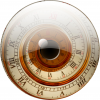
The purpose would be the line itself. If the inside of a shape is clear then the the line/outline would be the object that's needed. I use this function many times, everyday.
Ya kinda lost me on this one. Perhaps your asking how to remove a fill from a shape? If that's your question then Left click on the No color fill box on the bottom left of the screen.
Third box from the left, the one with the crosshatch.
When printing Seperations from Xara, Outlines are removed from fills. Then outlines are converted to editable shapes. Outlines duped & subtracted from the shape so as not to have overprint issues. Specifically Tapered outlines (which are RGB BTW) as these cause the most problems with cmyk seps from xara.
Lot's of reasons for the no fill usage.
----------- _~o
----------- '\<,, "He is no fool who gives what he cannot keep
><>____(_)/ (_) - in order to gain that which he cannot loose." JE



 Reply With Quote
Reply With Quote



Bookmarks